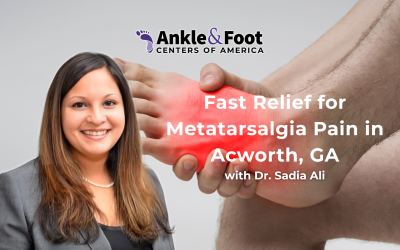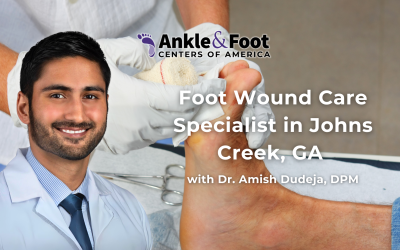Leg pain, foot ulcers, or cold toes may be early signs of peripheral vascular disease peripheral vascular disease (PVD). This common circulatory condition affects the blood vessels outside the heart and brain—especially in the legs and feet. Left untreated, it can lead to serious complications, including non-healing ulcers, toenail damage, and even limb loss.
Fortunately, advanced peripheral vascular disease treatments are available right here in Columbus, GA. Whether you’re managing PVD caused by diabetes, dealing with leg swelling or skin changes, or looking for relief from chronic foot pain, local specialists offer personalized care to help improve circulation and protect your long-term health.
Table of Contents
Understanding Peripheral Vascular Disease (PVD)
 Peripheral vascular disease (PVD) disrupts circulation by narrowing or blocking blood vessels, which limits blood flow—especially to the legs and feet. It often develops as a result of peripheral artery disease (PAD), a condition that specifically targets the arteries.
Peripheral vascular disease (PVD) disrupts circulation by narrowing or blocking blood vessels, which limits blood flow—especially to the legs and feet. It often develops as a result of peripheral artery disease (PAD), a condition that specifically targets the arteries.
As plaque builds up in the arteries (atherosclerosis), it restricts blood flow to muscles and tissues in the lower extremities. This reduced circulation leads to pain, numbness, weakness, and even skin damage over time.
PVD usually progresses slowly and may not show obvious symptoms early on. Catching it early and starting treatment helps prevent serious complications like ulcers, skin discoloration, or tissue loss.
Although anyone can develop PVD, it appears most often in people with diabetes, high cholesterol, or a history of smoking.
Common Symptoms of PVD in the Feet and Legs
 Peripheral vascular disease symptoms often start subtly but can progress over time. When blood flow to the lower limbs is restricted, it can affect the skin, muscles, and nerves in the feet, toes, and legs.
Peripheral vascular disease symptoms often start subtly but can progress over time. When blood flow to the lower limbs is restricted, it can affect the skin, muscles, and nerves in the feet, toes, and legs.
Here are some of the most common signs of PVD in the feet and legs:
-
Cramping or pain while walking (claudication)
-
Numbness, tingling, or weakness in the legs or feet
-
Cold feet or toes, even in warm environments
-
Skin discoloration—legs may appear pale or bluish
-
Slow-healing wounds or ulcers, which may indicate poor circulation or early stasis issues
-
Shiny skin or loss of hair on legs or feet
-
Toenail changes or brittle nails
-
Pain at rest or while lying down
These symptoms may worsen if left untreated. For individuals with diabetes, the risk of serious foot problems is even higher due to reduced healing capacity and sensation loss.
Recognizing the early warning signs and speaking to a specialist in Columbus, GA can help prevent long-term damage and improve your quality of life.
Complications of Untreated PVD
When peripheral vascular disease is left untreated, it can lead to serious and sometimes irreversible complications—especially in the legs, feet, and toes.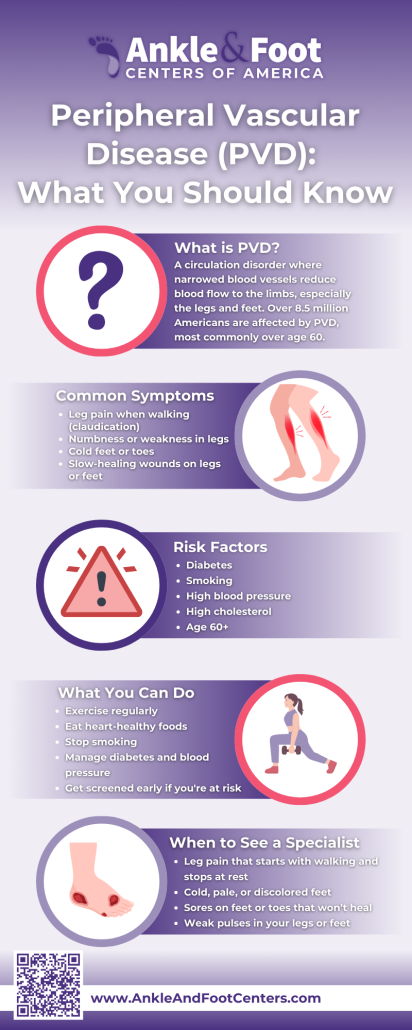
Common Complications Include:
-
Chronic ulcers – Whether caused by arterial or venous issues, ulcers in the lower legs and feet can become painful, infected, and slow to heal.
-
Critical limb ischemia – A severe blockage of arteries in the legs that can cause constant pain, open sores, and even tissue death.
-
Infections and gangrene – Decreased blood flow makes it harder for your body to fight infections, increasing the risk of amputation.
-
Amputation – In advanced cases, loss of circulation may require removal of a toe, foot, or leg to prevent further spread of infection.
-
Heart disease or stroke – Poor coronary circulation and widespread atherosclerosis can lead to life-threatening cardiovascular events.
People with diabetes are at even greater risk, making early diagnosis and intervention critical.
Peripheral Vascular Disease Treatment Options in Columbus, GA
If you’re dealing with persistent leg cramps, cold feet, or non-healing foot ulcers, you may be experiencing signs of peripheral vascular disease (PVD). At Ankle & Foot Centers of America in Columbus, GA, our specialists provide advanced treatment options to restore circulation, relieve symptoms, and prevent complications.
Lifestyle and Preventive Care
We begin with a conservative approach tailored to each patient’s condition:
-
Smoking cessation support
-
Exercise and walking programs to boost circulation
-
Nutrition counseling to help manage cholesterol and blood sugar
-
Custom diabetic foot care plans for high-risk patients
Medication Management
Our podiatrists work closely with patients and their primary care providers to:
-
Prescribe blood thinners or antiplatelet medications
-
Monitor and control blood pressure, cholesterol, and diabetes
-
Recommend topical or oral treatments for ulcers or slow-healing wounds
In-Office Procedures
Depending on the severity of your condition, we may recommend:
-
Wound care and ulcer management for PVD-related foot complications
-
Non-invasive vascular testing to assess blood flow to your legs and feet
-
Referral coordination for surgical vascular intervention if needed
Expert Foot and Ankle Care
Our Columbus-based team focuses on preventing foot and toe complications from PVD, especially in patients with diabetes or poor circulation. With a proactive approach to foot health, we help you avoid limb-threatening infections and promote long-term mobility.
If you suspect you may have PVD or PAD, don’t wait. Our experienced foot and ankle doctors at Ankle & Foot Centers of America in Columbus, GA are here to help you take the next step toward better circulation and improved foot health.
Special Considerations for PVD in Diabetic Patients
Diabetes and peripheral vascular disease (PVD) are closely linked—and when combined, they can significantly increase the risk of serious foot complications. At Ankle & Foot Centers of America in Columbus, GA, our team understands the unique challenges faced by diabetic patients with PVD.
Why Diabetes Increases Risk
-
 High blood sugar levels can damage blood vessels and nerves, reducing circulation to the feet.
High blood sugar levels can damage blood vessels and nerves, reducing circulation to the feet. -
Loss of sensation (diabetic neuropathy) makes it harder to feel pain or injury.
-
Delayed healing increases the chances of infections and non-healing ulcers.
Because of these risks, even a small cut or blister can turn into a serious foot ulcer if blood flow is poor. Without proper care, ulcers can worsen and may lead to infection, hospitalization, or even amputation.
How We Help
At our Columbus office, we take a proactive approach:
-
Regular diabetic foot exams
-
Custom orthotics to reduce pressure and prevent skin breakdown
-
Ulcer treatment and ongoing wound care
-
Education on foot hygiene and proper footwear
We work with you to create a treatment plan that addresses both diabetes and PVD, helping you stay ahead of potential complications and maintain your quality of life.
When to See a Specialist in Columbus, GA
If you’re noticing cold feet, non-healing ulcers, or pain when walking, don’t wait to seek care. Early evaluation and treatment of peripheral vascular disease (PVD) can make a big difference in preventing long-term complications.
At Ankle & Foot Centers of America in Columbus, GA, our specialists are trained to identify circulation issues and create customized care plans that address both foot health and vascular concerns.
One of our trusted providers, Dr. Jennifer Monaco, is highly experienced in managing complex lower limb conditions related to PVD and diabetes. Patients appreciate her compassionate care and attention to detail. Be sure to read reviews for Dr. Monaco to see how she’s helped others in the Columbus community regain comfort and mobility.
If you’re experiencing symptoms of PVD in the feet, toes, or legs, schedule an appointment with our Columbus office today. Early intervention is the key to protecting your health and staying active.

Frequently Asked Questions (FAQ)
Q: What is peripheral vascular disease?
A: It’s a circulation disorder that affects blood vessels outside the heart and brain, commonly in the legs and feet.
Q: What causes peripheral vascular disease?
A: Common causes include atherosclerosis, diabetes, smoking, and high cholesterol.
Q: Is peripheral vascular disease hereditary?
A: Yes, a family history of vascular or heart disease can increase your risk.
Q: What is the difference between peripheral artery disease and peripheral vascular disease?
A: PAD refers specifically to blocked arteries, while PVD includes both artery and vein disorders.
Q: How does coronary circulation relate to PVD?
A: Poor circulation in peripheral vessels often signals similar issues in coronary arteries, increasing heart disease risk.

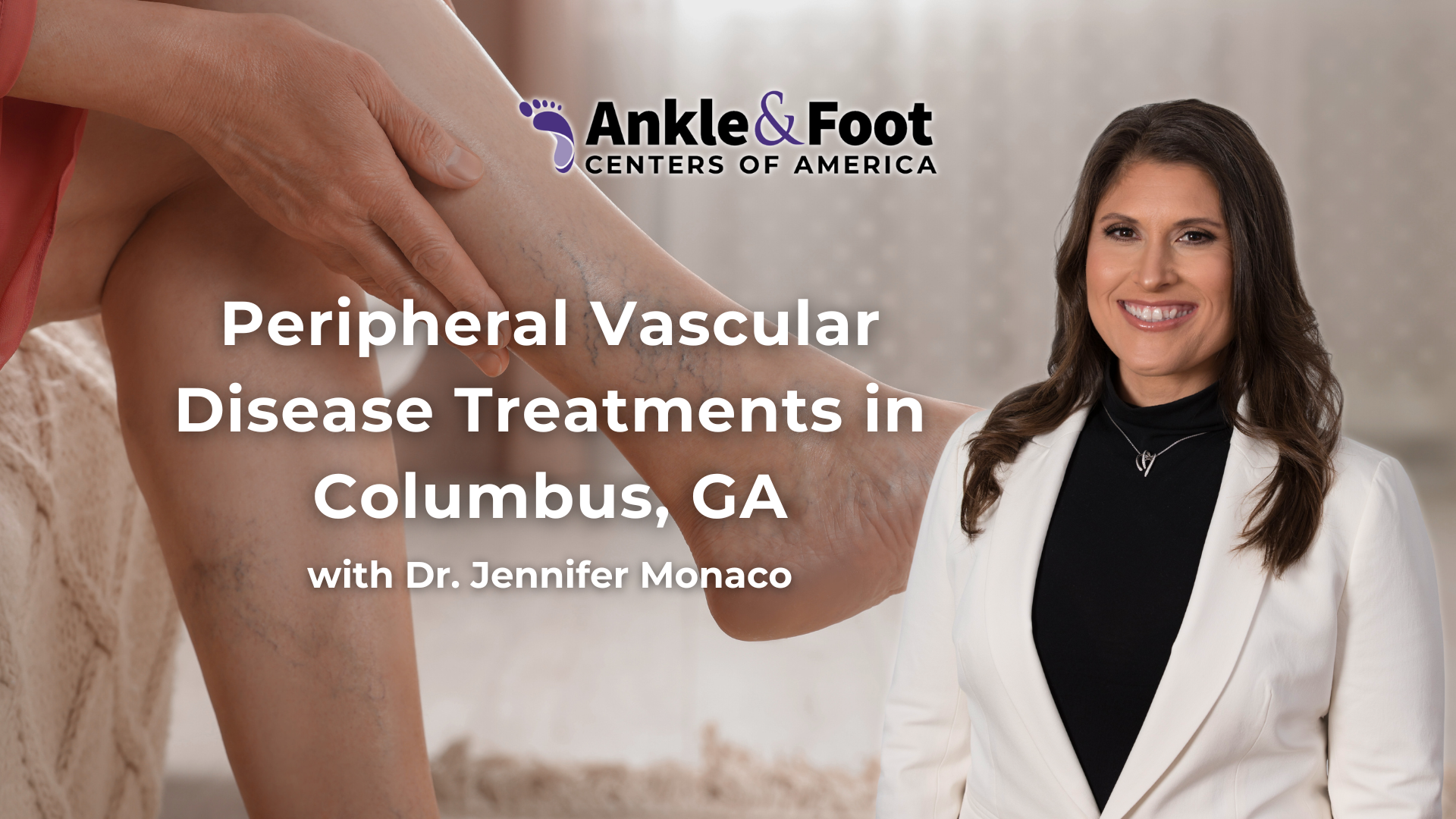
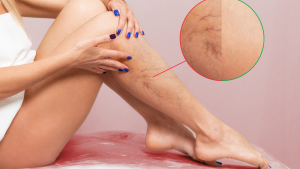 High blood sugar levels can damage blood vessels and nerves, reducing circulation to the feet.
High blood sugar levels can damage blood vessels and nerves, reducing circulation to the feet.

